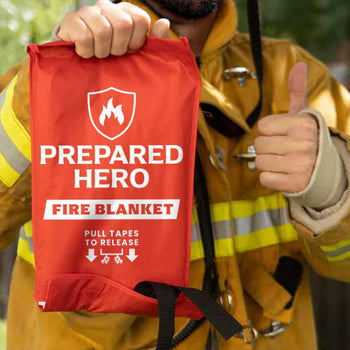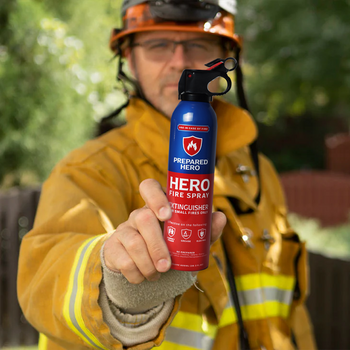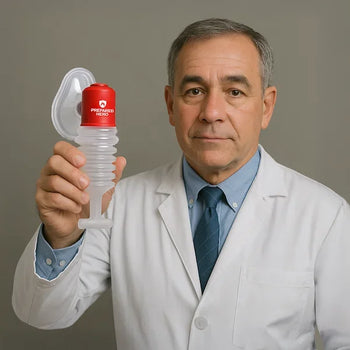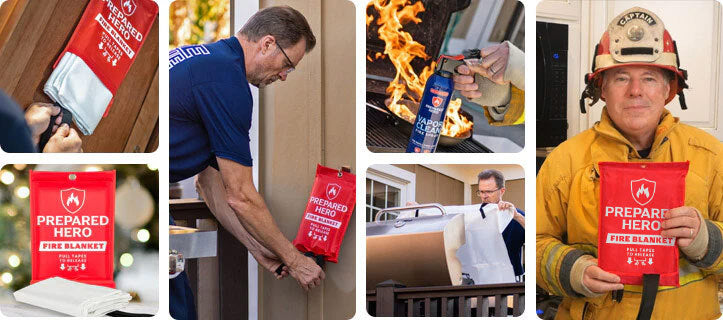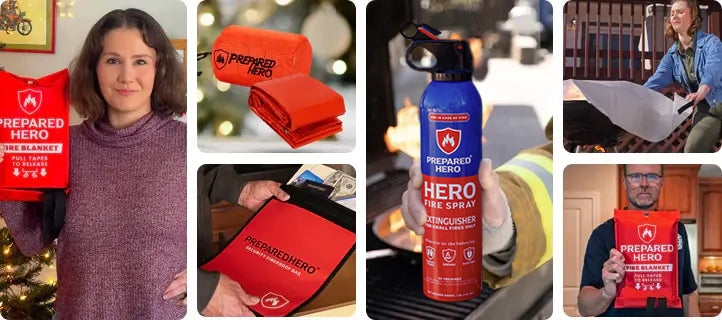Where you put your smoke detectors matters just as much as installing them. Proper placement makes sure they can detect...
Did you know? Smoke inhalation is one of the most common inhalation injuries. Plus, smoke inhalation injuries affect one-third of all burn injury victims.
Whether it’s from a structure fire, wildfire, or electrical fire, breathing in smoke can damage your lungs and airways. So, it’s important to know how to recognize symptoms, what treatments are available, and how to prevent these injuries from happening. In this guide, we’ll take a closer look at smoke inhalation injury symptoms, treatments, and prevention.
What Is Smoke Inhalation Injury?

Smoke inhalation injury happens when you breathe in a lot of smoke. It mostly happens during a fire. Smoke inhalation can damage your throat, lungs, and airways. The hot air can burn the inside of your airways, while the smoke can carry toxic gases like carbon monoxide and cyanide. These make it hard to breathe and can affect your brain, heart, and other organs.
Contrary to popular belief, the injury doesn’t just stay in your lungs. It can turn into a serious health problem that affects your whole body. It’s one of the main reasons people die in fires, even if they don’t get burned. The more smoke you breathe in and the longer you’re exposed, the worse it can get.
Even smoke from wildfires far away can be irritating, especially if you have asthma or other respiratory problems. If there’s a lot of smoke outside, stay indoors with the windows shut or wear a mask.
If you’ve been in a fire or inhaled a lot of smoke and start having trouble breathing, coughing, or feeling dizzy, don’t wait. Get medical help right away. Smoke inhalation is serious and needs quick medical attention.
Smoke Inhalation Injury Symptoms

Smoke inhalation can mess with your breathing, throat, and even your brain. Some symptoms show up fast, while others take time. Knowing what to watch out for helps you catch problems early and get medical help. Here are the symptoms of smoke inhalation injury:
1. Breathing Problems
One of the first signs of smoke inhalation injury is trouble breathing. This can include shortness of breath, fast breathing, and noisy breathing. You might also notice coughing that won’t go away, or feel like you can't breathe enough air. In more serious cases, your breathing becomes shallow and your oxygen levels drop.
2. Throat and Airway Irritation
Smoke can also burn and irritate your throat. This often leads to a sore throat or hoarse voice. Plus, you might feel pain when you breathe or talk. You might also notice swelling inside your mouth or throat, which makes breathing more difficult.
3. Changes in Your Voice or Sounds
Does your voice suddenly sound different, like it’s hoarse or weak? If yes, get yourself checked. Stridor (a high-pitched wheezing noise) might mean your upper airway is swelling. Don’t ignore this sign, especially after exposure to fire or smoke.
4. Physical Signs
There are also some signs you can see. Burns on the face or neck, singed nose hairs, or soot around the mouth or nose are common indicators. If there’s black or gray material in your spit, you’ve likely breathed in smoke.
5. Eye and Sinus Irritation
Light smoke can irritate your eyes and sinuses. Your eyes might sting, water, or turn red. Your nose could also feel stuffed or burned. These symptoms might seem minor, but they’re part of your body’s response to smoke exposure.
6. Lung Sounds
A doctor may hear abnormal sounds like wheezing, rales (crackling sounds), or rhonchi (a rattling noise) when listening to your lungs after smoke exposure. These are signs that the lower parts of your lungs may be inflamed or filled with fluid or mucus.
7. Mental and Neurological Symptoms
Breathing in toxic gases like carbon monoxide and cyanide can mess with your brain. You may feel dizzy, confused, or even faint. Headaches are also common. In severe cases, patients get seizures or lose consciousness completely.
8. Other Signs
In extreme cases, the airway can swell so much that it blocks breathing completely. This doesn’t always happen right away, so you should watch out for delayed symptoms. Some people may also develop complications like pneumonia, vocal cord damage, or ARDS (Acute Respiratory Distress Syndrome).
How Long Does It Take for Smoke Inhalation to Affect You?

Smoke inhalation can immediately affect you, while others take 24 to 36 hours. However, not all symptoms show up immediately. Symptoms that usually show up right away include coughing, wheezing, sore throat, and trouble breathing. Your eyes and nose might also start burning, and your chest might feel tight. That’s your body reacting to the irritation.
Some of the more serious effects, like lung damage or carbon monoxide poisoning, can take hours to develop. In fact, symptoms might not kick in until 24 to 36 hours after being exposed. This delayed reaction happens because some toxins go deep into your lungs and take longer to cause problems.
How fast symptoms appear also depends on a few things, like how much smoke you breathed in, what kind of materials were burning, and your general health. If you have asthma or another respiratory condition, symptoms may show up quicker or feel worse.
While some signs don’t show up right away, you should still keep an eye on how you feel after being around smoke. If you start to feel confused, have a hoarse voice, keep coughing, or struggle to breathe, get medical help. Remember, smoke inhalation can be serious, even if you feel fine at first.
What to Do If You Inhaled a Lot of Smoke

Breathing in too much smoke can mess with your body fast, even if you feel okay at first. Here’s what to do right away, what signs to watch for, and when to get medical help.
1. Get Fresh Air Immediately
If you’ve inhaled a lot of smoke, the first step is to move to fresh air right away. Don’t wait around—get out of the smoke as fast as you can. Staying in a smoky area only makes things worse.
2. Call for Medical Help
Call 911 if you’re having trouble breathing, your voice is hoarse, or you’re coughing a lot. Even if the symptoms seem mild, it’s best to get checked by a doctor. Plus, smoke inhalation can affect your lungs and brain fast, so it’s better to be safe than sorry.
3. Watch Out for Serious Symptoms
Keep an eye out for signs like chest pain, wheezing, dizziness, and confusion. If you notice black or gray spit, burns in your mouth or nose, or changes in skin color (like it turning blue or red), get help immediately. These could be signs of serious internal damage.
4. Rest and Stay Hydrated
Give your body time to recover after smoke exposure. Rest and drink plenty of fluids. Water helps thin out mucus and keeps your airways moist. Avoid alcohol or caffeine as well because they can dehydrate you.
5. Stay Away from More Smoke
Try to avoid smoky areas or anything that could irritate your lungs, like dust and strong chemicals. If there’s smoke outside, stay indoors with the windows shut. Plus, wear a proper mask if you must go out.
6. Don’t Ignore Delayed Symptoms
Some symptoms can take up to 36 hours to show up. If your breathing gets worse or you feel off in any way, go back to the doctor.
How Long Does It Take To Recover From Chemical Inhalation?

It can take hours, days, weeks, or months to recover from chemical inhalation, depending on how severe the case is, what chemical you were exposed to, how much you breathed in, and your overall health.
Some people recover in a few hours with fresh air and rest. Others recover in days, weeks, or months, especially if the exposure was severe or if they already had respiratory problems.
Mild cases usually clear up within a day, especially if the person gets fresh air quickly, gets medical help immediately, and drinks plenty of fluids. Moderate exposure might take a few days to a few weeks to recover from, and there may be lingering symptoms like coughing or shortness of breath. On the other hand, recovery can stretch over many weeks or months for more serious inhalation injuries. In some cases, people may be left with lasting respiratory issues like lung scarring or difficulty breathing.
You should also take note that some symptoms don’t show up right away. It can take a day or more for the effects to kick in. That’s why it’s important to get checked by a doctor even if you feel fine at first. Quick medical attention makes a huge difference and helps you avoid long-term damage.
What Does Smoke Inhalation Do to the Body?
Smoke inhalation brings in harmful chemicals that can mess with your airways, lungs, and oxygen levels. Carbon monoxide and cyanide are dangerous substances that can get into your system and cause poisoning. While smoke inhalation doesn’t always show visible signs like burns, it can still be deadly if not treated right away.
Even if you’re not burned, smoke inhalation can cause symptoms that affect your whole body. You might notice your skin turning pale, blue, or red. Breathing also becomes painful or short. You’ll also cough, have a hoarse voice, or get confused. Some people feel nauseous or dizzy, and their eyes might burn from the smoke.
In addition, the lack of oxygen can make things worse for people with heart problems, like heart failure or arrhythmias. Smoke inhalation also puts extra strain on the heart. However, don’t think it’s only an issue for those with existing heart conditions. Healthy people can still have heart problems from smoke inhalation because they’re not getting enough oxygen.
How Do You Treat a Smoke Inhalation Injury?

From oxygen therapy to medications and even ventilators, doctors use a range of methods to help your body heal and prevent further damage. Here are the treatments for smoke inhalation injury:
1. Oxygen Therapy
The first line of treatment for smoke inhalation is oxygen. It’s crucial to get your oxygen levels back to normal quickly. You’ll likely be given oxygen through a face mask or nose tube. In more severe cases, a tube is inserted into one’s throat to help them breathe.
2. Hyperbaric Oxygen Therapy
If you’ve been exposed to carbon monoxide, hyperbaric oxygen therapy may be used to treat you. This treatment involves being placed in a special chamber and given high doses of oxygen. The oxygen helps remove carbon monoxide from your blood and gives your body the oxygen it needs to heal.
3. Medications
Several medications may be used to manage symptoms and complications of smoke inhalation:
-
Bronchodilators help open up the airways, so it’s easier to breathe.
-
Mucolytics break up mucus in your lungs, so it’s easier to clear out.
-
Antibiotics prevent or treat infections, especially if there’s lung damage.
-
Anti-clotting drugs (anticoagulants) may be given to prevent blood clots.
-
Hydroxocobalamin, a form of vitamin B12, is used to treat cyanide poisoning.
4. Intubation and Ventilation
If smoke inhalation is severe and you’re having trouble breathing, doctors might use a ventilator to help you breathe. Sometimes, a breathing tube is inserted into your throat to make sure air can get into your lungs.
5. Additional Supportive Measures
Doctors may also give you IV fluids to keep you hydrated. However, they have to be carefully monitored to prevent lung swelling. They might also administer pulmonary hygiene, like suctioning airways to clear out debris from the lungs.
These treatments vary based on the severity of the smoke inhalation injury, but the goal is to restore oxygen levels, protect the lungs, and prevent further complications.
How to Prevent Smoke Inhalation Injury

Smoke inhalation can be dangerous, but there are several ways you can prevent it. Here’s what you can do to protect yourself and your loved ones:
1. Install Smoke Detectors
Start by installing smoke detectors in the right areas. The NFPA (National Fire Protection Association) recommends placing them in every bedroom, outside of each sleeping area, and on every level of your home.
2. Don’t Forget Carbon Monoxide Detectors
Carbon monoxide is another silent danger. This helps protect you from carbon monoxide poisoning, which can also come from smoke inhalation. Find out where to place carbon monoxide detectors here.
3. Test and Replace Batteries Regularly
Having smoke and carbon monoxide detectors is only effective if they’re working properly. Test them monthly to make sure they’re in good shape. The NFPA also recommends changing smoke detector batteries at least once a year. Check out how to replace smoke detector batteries here. On the other hand, carbon monoxide detector batteries should be replaced every six months.
4. Have an Escape Plan
Emergencies can happen fast, so you should plan ahead. Make an escape plan in case of fire and practice it with your family. Knowing exactly what to do and where to go can save lives in an emergency.
5. Don’t Leave Fire Hazards Unattended
It’s easy to forget, but leaving fire hazards like lit candles, cigarettes, or space heaters unattended can quickly lead to a fire. Always extinguish them properly and dispose of any smoking materials safely. You should also have a fire kit with a fire blanket, fire spray, and flame shield nearby to prevent small fires from spreading and stay safe.
6. Be Careful in the Kitchen
Cooking can easily lead to a fire if you’re not paying attention. Never leave the kitchen unattended while cooking, especially when using hot vegetable oil or open flames.
Conclusion
Smoke inhalation injuries are more serious than most people think. They can damage your lungs, mess with your breathing, and affect your brain and heart. Some symptoms don’t show up right away, so stay alert and get help fast. Knowing what to do, when to seek care, and how to prevent it makes all the difference.
Do you want reliable, easy-to-use, and affordable tools to put out small fires before they spread? Check out Prepared Hero’s fire prevention tools here, and get up to 51% off on certain items. Stay prepared, hero!


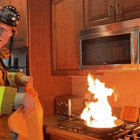 Fire
Fire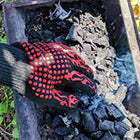 Safety
Safety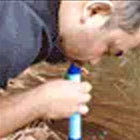 Survival
Survival Protection
Protection New
New
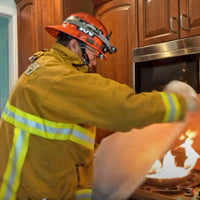 Fire
Fire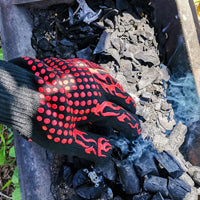 Safety
Safety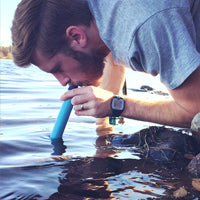 Survival
Survival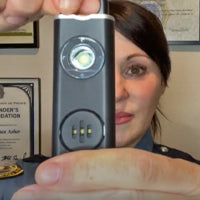 Protection
Protection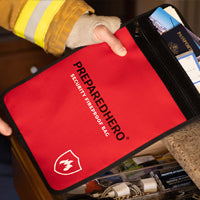 New
New
